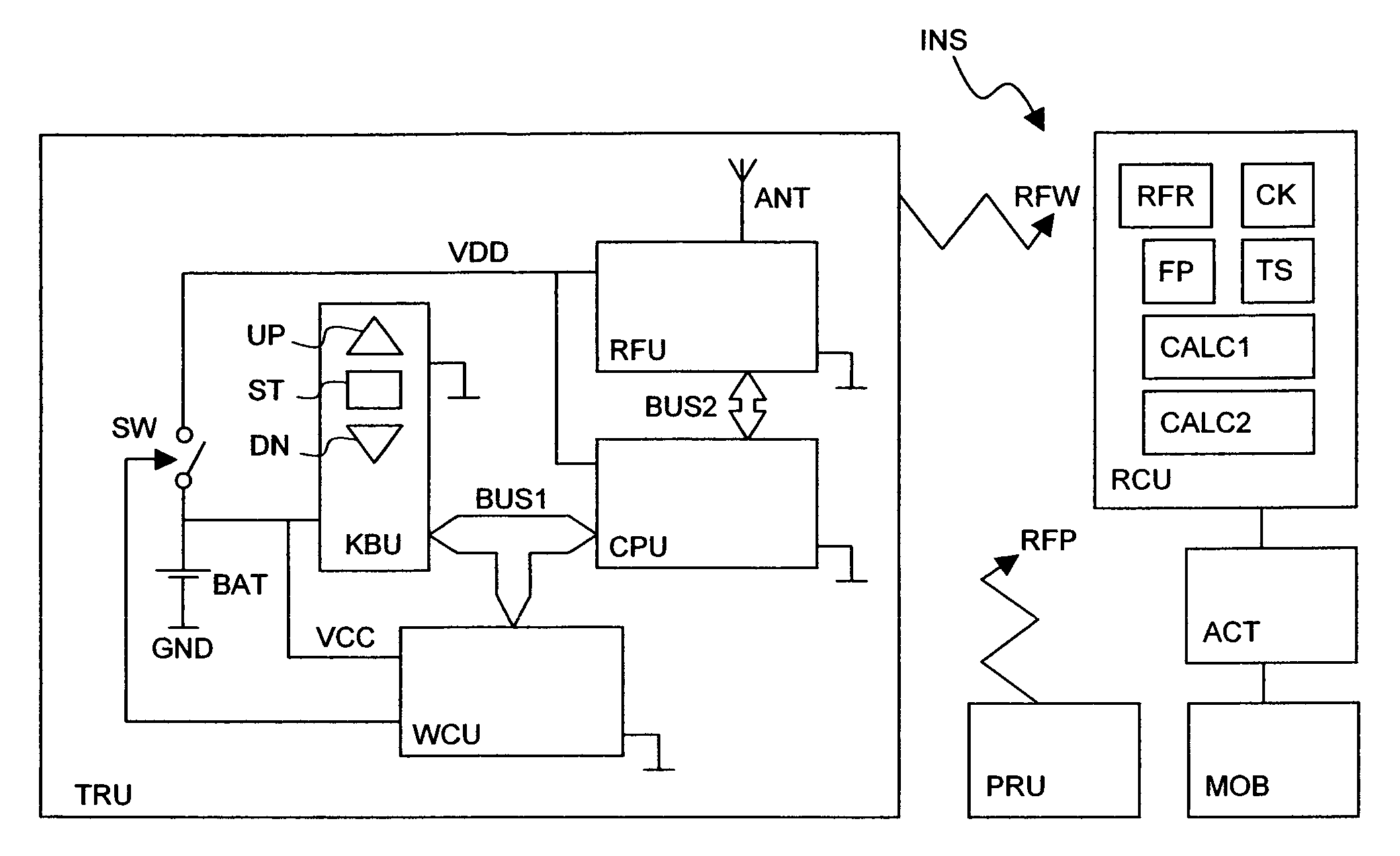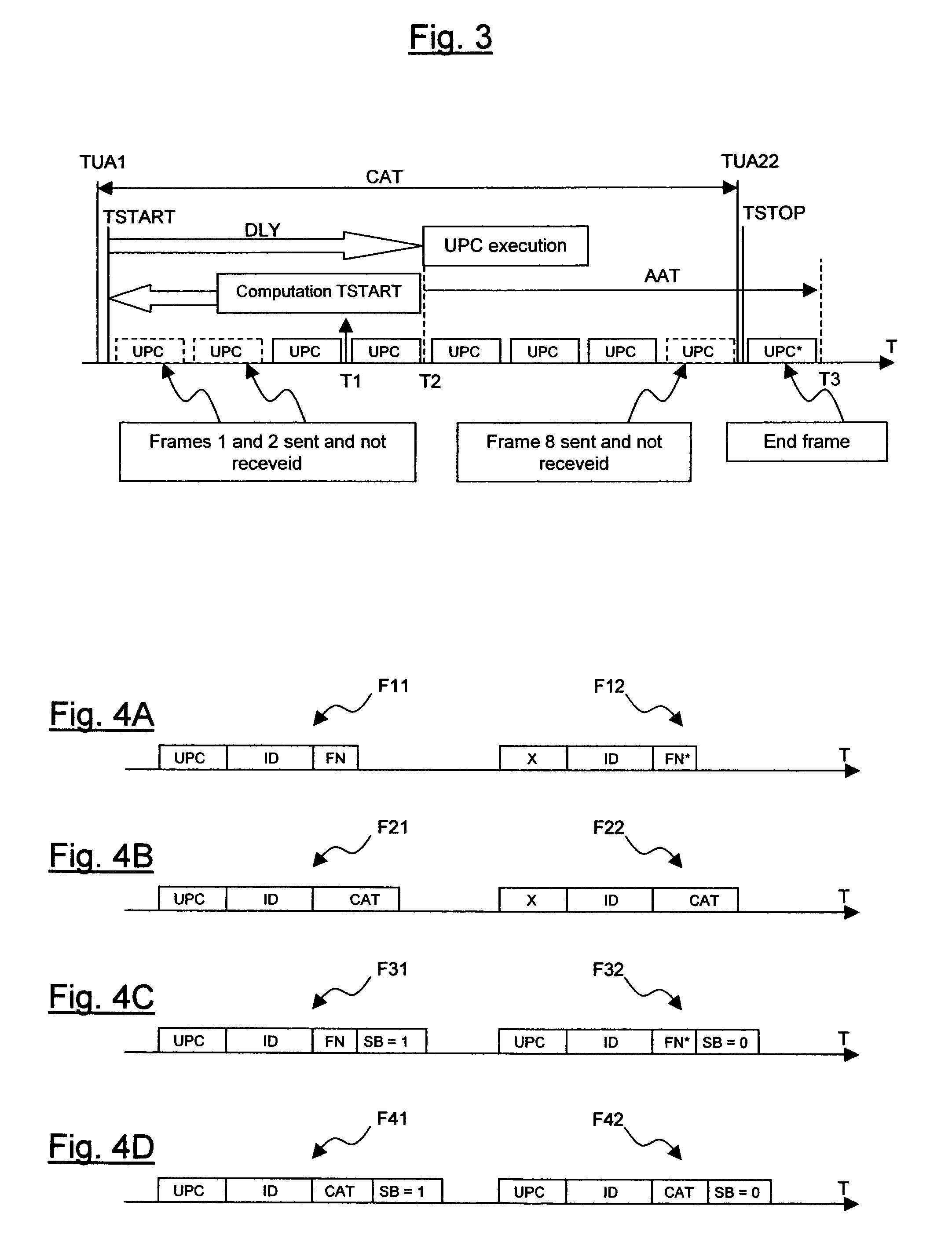Actuator control method
a technology of actuator control and actuator, which is applied in the direction of transmission, wireless commuication services, transmission systems, etc., can solve the problems of poor reception of a signal sent, receivers can be at the range limit, and the likelihood of failure to receive certain repeated frames is high
- Summary
- Abstract
- Description
- Claims
- Application Information
AI Technical Summary
Benefits of technology
Problems solved by technology
Method used
Image
Examples
first embodiment
[0057] the invention is first used to enable good synchronization of all the actuators on startup. To overcome a possible transmission failure, the designer has provided for the startup of any actuator to take place at the end of the fourth frame sent (for a frame of 140 ms, this amounts to supporting a delay of around half a second). A time delay DLY is associated with this value.
[0058]At the instant T1, the receiver has therefore received its first frame. Based on the time indication contained in this frame, it computes the theoretical instant of the start of sending TSTART, close to the actual instant CAT21 of pressing on the control key. From the value of the time delay duration DLY, it computes the time remaining before activating the control UPC to be applied to the actuator. The durations can be expressed as a number of frames: for example, the duration DLY corresponds to an integer number NSTART of frame periods, in this case NSTART=4, but it is also possible to take a non-i...
second embodiment
[0085]FIG. 7 represents a synchronization method according to the invention, in which there is no desire to obtain synchronized operation of actuators obeying one and the same general command, but in which it is desired for the moving elements MOB driven by these actuators to be subject to an identical displacement, or at least a very similar displacement, after a control. The displacements are then matched by correction at end of movement.
[0086]This correction incorporates both the effects of poor reception at the start of sending and of poor reception at the end of sending.
[0087]In FIG. 7, the time information item consists of the control frame number FN and the control end frame number FN*.
[0088]In the step 701, the control received is interpreted, as in the step 601.
[0089]In the step 702, the frame number is extracted for use in the step 703 to determine the theoretical sending start instant TSTART.
[0090]Unlike the method of FIG. 6, this time the actuator is activated directly i...
third embodiment
[0100]FIG. 9 now represents a method of programming according to the invention. The method applies to the programming unit PRU, and more particularly to the programming controls that can be sent from this unit while being compatible with programming controls sent from transmission units TRU. The press on a particular PRU key provokes the sending of the control PROG. The programming method differs from the sending method of FIG. 5 solely by the content of the step 502. In FIG. 9, the corresponding step 902 is the only one shown, the steps 901 and 903-906 being like the steps 501 and 503-506 of FIG. 5.
[0101]In the step 902, the time indication introduced into the frame is deliberately offset by a quantity equivalent to the press time needed for confirmation of the control PROG by the receiver. For example, the initial press duration information item is introduced as being equal to 10 seconds, although the press has only just begun. Alternatively, the number of frames is set to the ini...
PUM
 Login to View More
Login to View More Abstract
Description
Claims
Application Information
 Login to View More
Login to View More - R&D
- Intellectual Property
- Life Sciences
- Materials
- Tech Scout
- Unparalleled Data Quality
- Higher Quality Content
- 60% Fewer Hallucinations
Browse by: Latest US Patents, China's latest patents, Technical Efficacy Thesaurus, Application Domain, Technology Topic, Popular Technical Reports.
© 2025 PatSnap. All rights reserved.Legal|Privacy policy|Modern Slavery Act Transparency Statement|Sitemap|About US| Contact US: help@patsnap.com



